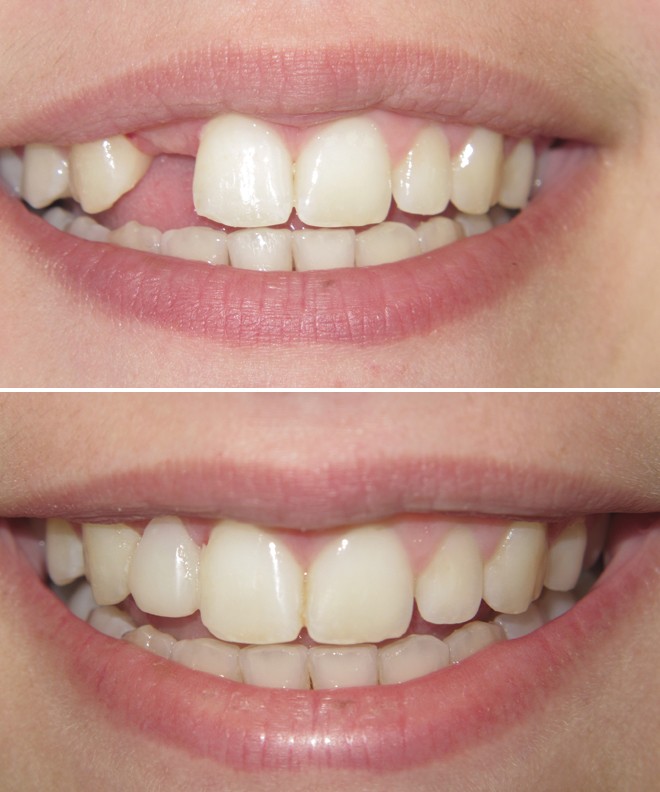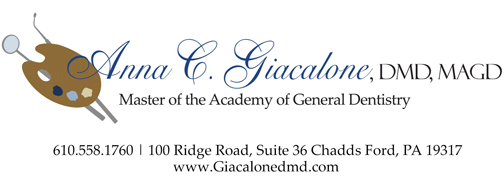Slighted By The Tooth Fairy

By Anna Giacalone, D.M.D.
About 20% of people don’t get the standard issue of 32 permanent teeth!!! The third most common teeth to be congenitally missing are lateral incisors. Lateral incisors are the teeth to the right and left of the two center teeth. These are by far the most challenging to replace and the focus of this article.
The lateral incisors normally erupt at about six years old. Since going through childhood without these teeth has an impact on self-esteem and speech development, we usually provide temporary tooth replacement by placing a plastic tooth on the orthodontic archwire or on a removable retainer. Unfortunately decisions for definite tooth replacement, after growth is complete, must be planned at an early age, usually 8 – 10 years. The dentist, orthodontist and the family need to consider the risk/benefits of the long – range solutions using statistical data, genetics, and clinical judgment. No one can 100% predict the growth pattern of any individual patient.
Most dentists agree that the most ideal treatment keeps the natural teeth in the position for which they were designed and replaces the missing lateral incisor(s). While it is possible to close the space left by the missing lateral incisors by orthodontically moving all the permanent teeth forward, it is a compromise. The canine, eye tooth, is moved into the position next to the central tooth where the lateral incisor should be. The problem is that the shape of the canine tooth and root of the canine is nothing like that of the delicate lateral incisor. The canine can be reshaped and restored to look fairly good but the bulky root remains. More importantly we have lost the function for which the beefy canine was designed. The canine root is important for mouth shape and support of the corner of the mouth. The canine in its proper location guides the jaw in side to side movement, protecting back teeth from unfavorable forces which can contribute a host of pathologic events. The premolar tooth which has been orthodontically moved into the canine position has one or two delicate spindly roots. These roots are not nearly as resistant to functional demands as the canine.
Closing the space by orthodontic repositioning is not without its benefits. Permanent tooth replacement is available at an early age, when orthodontic treatment is complete. This eliminates the obligation to maintain the space and precise root position of teeth next to the space for the years between orthodontics and permanent tooth replacement, when growth is complete. The repositioned canine tooth can be modified slightly immediately following orthodontics but definitive restoration of the tooth is best completed when mouth growth and development is complete.
The most ideal tooth replacement today is the dental implant. Implants are little more than artificial roots placed into the bone upon which a tooth is built. The implant looks and feels very much like a natural tooth. It preserves the bone and permits all other teeth to function as they were designed. The problem is that maintenance of the orthodontic result is imperative as previously discussed. Even when maintenance is perfect, there may be unpredicted growth patterns or insufficient bone to place an implant without additional preparation of the site.
Obviously there are many considerations when treatment planning for a young person who is missing a lateral incisor. Finances, temperament/cooperation of the patient, genetics all play a role. The tooth Fairy’s slight creates quite a challenge.

Anna C. Giacalone, DMD, MAGD
Master of the Academy of General Dentistry
Education:
• BS. Biology Chestnut Hill College
• DMD. University of Pennsylvania School of Dental Medicine
• Certificate and Internship: Comprehensive Orthodontic Institute
• Certificate: prestigious Dawson Academy of Advanced Study
Awards:
• Pennsylvania Dental Association Award for Excellence during the four years of dental school
• Top Cosmetic Dentist Main Line 2007, 2011-2014 (chosen by peers)
• Top Dentist in Delaware Valley, 2008; Delaware Valley Consumer Checkbook (chosen by patients)
• America’s Top Dentists 2010 – 2014 Consumer Research Counsel
• Mastership in the Academy of General Dentistry 2013
To learn more visit her web site: www.giacalonedmd.com


